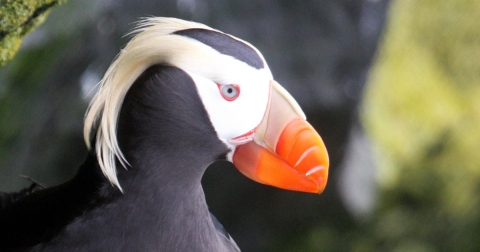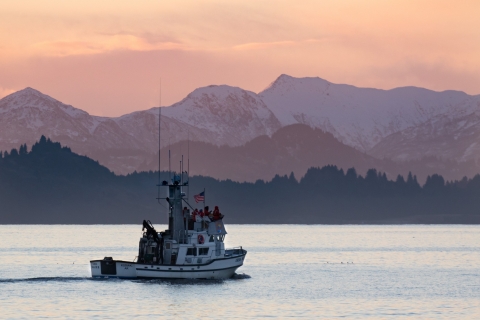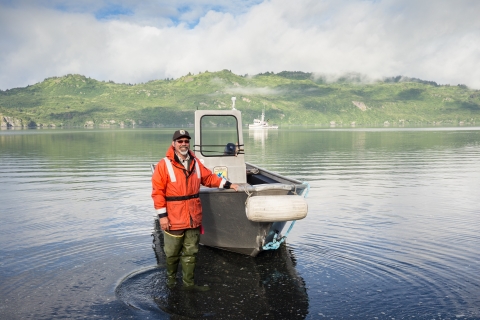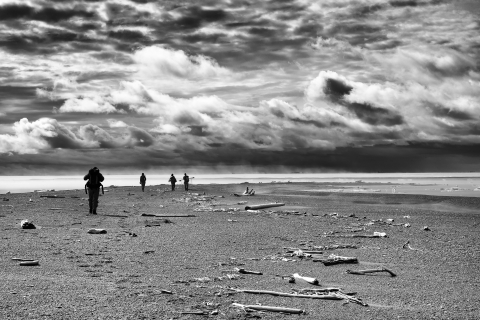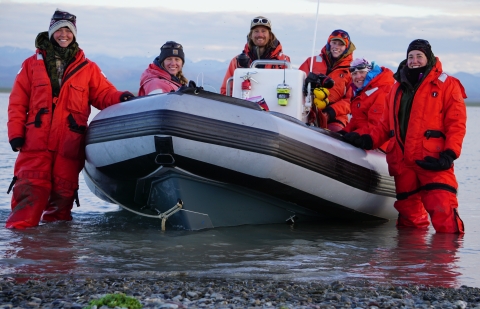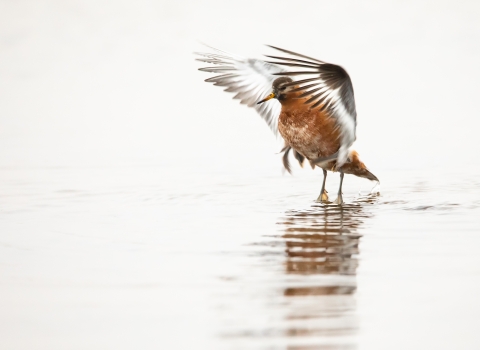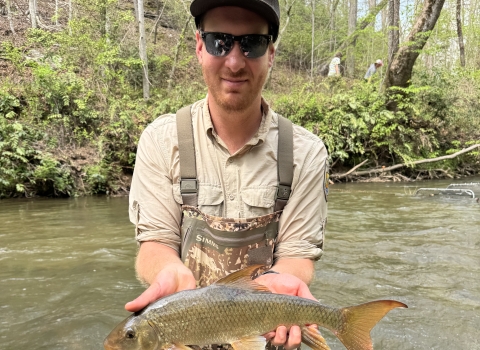From spunky inflatable skiffs to a fully equipped 120-foot research ship, boats give our scientists access to the immense 6,640 mile coastline of Alaska (over 30,000 miles if you count all the islands. Which we do.). Boats also help us to study the wildlife that depends on the diverse marine waters of two oceans with three different seas (the North Pacific and Arctic Oceans, along with the Bering, Chukchi, and Beaufort Seas). It’s a big, watery world out there, and we invite you to join us for a brief cruise on three of our vessels as they sail the remote reaches of the state.
The R/V Tiĝlax̂
Captain: John Faris
Home Port: Homer, Alaska
Visiting the far-flung islands and coast of Alaska Maritime Refuge almost always requires a boat. The refuge’s 3.4 million acres include the spectacular volcanic islands of the Aleutian chain, the seabird cliffs of the remote Pribilofs, and icebound lands washed by the Chukchi Sea, and provides essential habitat for some 40 million seabirds, representing more than 30 species.
Since 1987, the R/V Tiĝlax̂ has been plying the wild waters of coastal Alaska, ferrying biologists to remote camps and serving as a platform for nearshore research. The Tiĝlax̂ (TEKH-lah — Unangam Tunuu for eagle) and its crew are a vital to managing the Alaska Maritime National Wildlife Refuge, which stretches from Southeast Alaska to the far western end of the Aleutian Chain, and into the Bering Sea. She is steady but not speedy; the Tiĝlax̂ typically travels 12,000 to 20,000 nautical miles a year at a speed of 10 knots (about 11 mph).
Keeping Watch for Oceanic Change
Researchers aboard the Tiĝlax̂ study ocean conditions and the marine food web in the nearshore waters adjacent to critical seabird colonies and marine mammal rookeries in the Gulf of Alaska and Bering Sea. Watching for change is critical to understanding species decline and possible causes, including climate change climate change
Climate change includes both global warming driven by human-induced emissions of greenhouse gases and the resulting large-scale shifts in weather patterns. Though there have been previous periods of climatic change, since the mid-20th century humans have had an unprecedented impact on Earth's climate system and caused change on a global scale.
Learn more about climate change .
The Tiĝlax̂ sets out and picks up seabird monitoring field camps (eight different sites spread out through the islands of the refuge) and visits periodically during the summer, bringing news and fresh food to the uninhabitated islands where the work is carried out. The crew also makes time for village visits and hosts educational tours for summer campers in remote communities.
R/V Ursa Major II
Captain: Jeff Lewis
Home Port: Kodiak, Alaska
The famous furry resident of Kodiak (Ursus arctos middendorffi) and the Great Bear constellation inspired the name of the research vessel built for Kodiak Refuge, the R/V Ursa Major II. This 49-foot boat carries a small crew each year to survey the seabirds and marine mammals of the Kodiak area. Nestled in the Gulf of Alaska, south of the Kenai Peninsula, the Kodiak Archipelago is a group of islands bound by the sea with over a thousand miles of convoluted coastline. The nearly 2 million acre refuge spans the main island of Kodiak (the second largest island in the United States), Ban and Uganik Islands, and the northwestern portion of Afognak Island.
For several weeks during the summer, the refuge’s avian biologist and two or three volunteers live aboard the Ursa Major II, which can sleep six people. Like the Tiglax, this small vessel is self-contained and carries everything the researchers will need to conduct their surveys along remote coastlines, including a skiff that can run five-kilometer transects across ocean waters.
The shelter of island cliffs and the bounty of the North Pacific Ocean support colonies of breeding seabirds, including black-legged kittiwakes, tufted and horned puffins, Arctic and Aleutian terns, cormorants, and pigeon guillemots. By monitoring the populations of seabirds over time, scientists can gather a lot of information about the overall health of oceans. In Kodiak, researchers are especially interested in the apparent decline of Aleutian and Arctic tern colonies along the coast, and are trying to learn more about the possible causes.
Welcome Aboard!
The R/V Ursa Major II home ports in the fishing community of Kodiak year round, where boats are a big part of life. In addition to hosting research and carrying supplies to the roadless refuge, the Ursa also welcomes visitors and volunteers aboard for education and citizen science, including the annual Audubon Christmas Bird Count. Each year, the Ursa Major II brings exhibits and displays about the refuge in a “floating visitor center” to one of six remote coastal communities: Ouzinkie, Port Lions, Akhiok, Larsen Bay, Karluk, or Old Harbor. Local school classes join the captain aboard and learn about how the boat supports science.
Arctic Inflatables
Skiff Captains: Elyssa Watford, Elizabeth Schell, and Will Wiese
Home Port: the Arctic Coast
The barrier islands of the Arctic coast are a unique ecosystem: narrow edges of gravel and sand that separate large spaces of protected lagoon waters from the open ocean and drifting sea ice. Mostly flat and with little vegetation, they catch “wrack lines” of weathered driftwood from rivers hundreds of miles away.
Birds make their home here, gulls call and wheel overhead, and tiny chicks run up and down the water‘s edge under the midnight sun of June and July. Common eiders are an indicator species for this ecosystem: by studying their health and learning more about them, we can better understand the conditions of other birds that call the barrier islands home. As the Arctic warms, the extent of sea ice becomes more sparse in the summer and into the fall, leaving these island edges and their nesting inhabitants more vulnerable to storm surges and flooding from the open water.
The crew that studies the common eider along these wild islands rely on two inflatable boats and can operate self-sustained with proper camping and safety equipment. Over several days, they might travel from a refuge base camp to the eastern boundary of Alaska and Canada in Demarcation Bay and back, living in small tents and monitoring nests and islands along the way.



